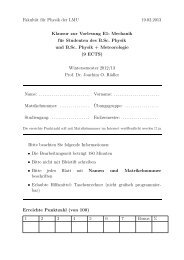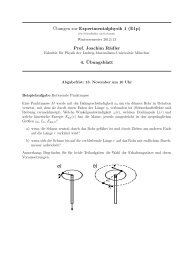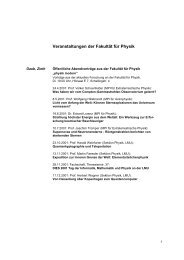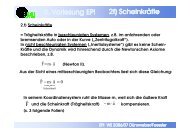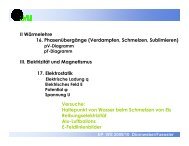Spatially Resolved Surface Acoustic Wave Studies For Image ...
Spatially Resolved Surface Acoustic Wave Studies For Image ...
Spatially Resolved Surface Acoustic Wave Studies For Image ...
Create successful ePaper yourself
Turn your PDF publications into a flip-book with our unique Google optimized e-Paper software.
[7]. This causes an increase of the SAW frequency<br />
along the aperture. Hence, the resulting<br />
SAW intensity transmission signal of a delay<br />
line consisting of two fan-shaped IDTs is<br />
a frequency bandpass. <strong>For</strong> a frequency within<br />
such a bandpass the IDT matches the resonance<br />
only in a confined part of the aperture and<br />
launches a SAW only on a narrow path. If<br />
multiple split fingers are used, internal reflections<br />
are reduced and one has the opportunity<br />
to work also with higher harmonics of the resonant<br />
ground frequency with one single delay<br />
line. The value bandpass/middle frequency is<br />
approximately the tapering factor which represents<br />
a constant value. Therefore, the absolute<br />
value of the bandpass spreads with higher harmonics.<br />
A typical transmission signal of this design<br />
is shown in fig. 1.<br />
The width of the SAW path limits the spatial<br />
resolution. It was already shown that the width<br />
decreases with increasing tapering factor before it<br />
reaches a minimum and then increases again due<br />
to diffraction [8]. Diffraction gains in importance,<br />
if the confinement reaches the order of the wavelength.<br />
Sauer et al. have been able to directly<br />
demonstrate diffraction for GaAs by X-ray imaging<br />
[9]. The typical width of a SAW path for an<br />
IDT with a tapering factor of 10%, an aperture<br />
of 450 m and a driving frequency of 600 MHz is<br />
approximately 50 m.<br />
In the case of a GaAs(001) surface the symmetries<br />
along the [110] and [-110] axis are equivalent.<br />
Therefore the transmission signals of perpendicular<br />
SAW delay lines are the same. The transmission<br />
signal in x and the perpendicular direction<br />
of a LiNbO 3 128 ◦ rot. Y-cut surface is different.<br />
On the last-mentioned substrate and for our delay<br />
line layout the transmission in x-direction is<br />
10 dB higher than in the perpendicular one.<br />
III. Sensitivity of Different Materials,<br />
the Linear Regime<br />
We measure amplitude and phase of the transmitted<br />
SAW signal with and without illumination<br />
of a spot being 5 m in diameter on our SAW<br />
delay line. The light source is an Argon laser<br />
(λ=488 nm). The SAW signal changes for frequencies<br />
and a corresponding SAW path intersecting<br />
the area where light induced charge carriers<br />
are present. We measure a peak in the relative<br />
change of phase and amplitude vs. the frequency<br />
bandpass. The FWHM of this peak corresponds<br />
to a larger spot size in real space than the spot of<br />
the light. The difference between the measured<br />
and the real spot size is due to the finite width<br />
transmission [dB]<br />
S 21<br />
-20<br />
-30<br />
-40<br />
-50<br />
-60<br />
-70<br />
-80<br />
1.harm. 3.harm. 5.harm. 7.harm.<br />
100 200 300 400 500 600 700 800 900<br />
frequency [MHz]<br />
Fig. 1. Transmission signal S 21 of a delay line with<br />
fan shaped split 4 IDTs. The taper factor is 10%.<br />
Maximum transmission occurs at the odd harmonics<br />
of the IDT periodicity. Here, we show the<br />
odd harmonics 1 through 7.<br />
of the SAW path (as shown in section II) and the<br />
diffusion of charge carriers.<br />
The relative change in phase and amplitude of<br />
the transmitted SAW signal changes with different<br />
material properties and different driving frequencies<br />
of the device. In this work we present<br />
three different GaAs devices. The first one is pure<br />
GaAs, which is characterized at the two different<br />
driving frequencies 440 and 825 MHz. With increasing<br />
frequency more wavelenghts fit into the<br />
illuminated area and hence the sensitivity of the<br />
device increases (compare triangled symbols in<br />
fig. 2). In GaAs grown at low temperatures (LT-<br />
GaAs) the mobility of electrons is lower (µ e in the<br />
order of 10 2 cm 2 /Vs) as compared to the electron<br />
mobility in GaAs grown at higher temperatures<br />
(µ e = 8·10 3 cm 2 /Vs). To reach the same sheet<br />
conductivity σ = en e µ e , where e is the elementary<br />
charge, one has to increase the two dimensional<br />
electron density n e . Consequently one has<br />
to generate more charge carriers to get the same<br />
conductivity. This is shown in fig. 2 squared data




